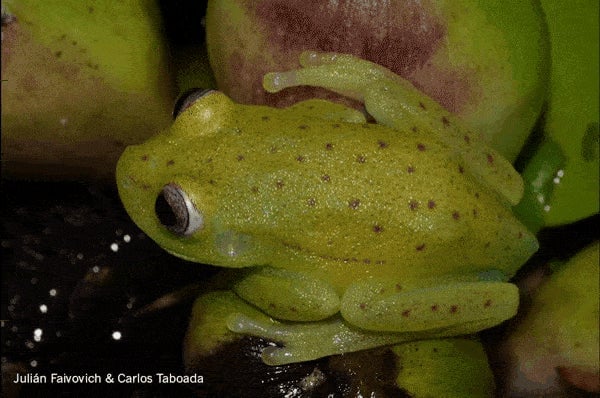A fashionable frog is the first fluorescent amphibian known to humanity
Land animals rarely have that glow known as fluorescence. But now scientists have found a frog with this power, the first such amphibian known to humanity.


Land animals rarely have that glow known as fluorescence. But now scientists have found a frog with this power, the first such amphibian known to humanity.
A study published in the Proceedings of the National Academy of Sciences on March 13 introduced the world to the secret powers of the South American polka-dot tree frog. The researchers, led by Carlos Taboada and Julián Faivovich, herpetologists at the University of Buenos Aires in Argentina, were surprised by the bright green glow they spotted when they first flashed an ultraviolet light at the frog. “We couldn’t believe it,” Faivovich told Nature.
Fluorescence is distinct from bioluminescence (found in fireflies, for example, and many sea creatures), in which the animal generates its own light chemically. A fluorescent creature, by contrast, can absorb light at short wavelengths and re-emit it at longer ones. The tree frog appears to do this in a way that’s unlike other fluorescent species, though researchers don’t yet know exactly how or why. Based on how much light it emits, however, they posit that the fluorescence helps with night vision and may be connected to mating.
The frog is not only a scientific wonder, but something of a fashion phenomenon as well. In regular light, it sports a coat of somewhat muted 1970s hues—a pale mustard with cinnamon spots. But shine an ultraviolet light on it and you discover a wilder side: fluorescent green with dark dots, perfect for a night at the club, circa 1985.
Scientists believe the tree frog’s fluorescence contributes about a quarter of the light it relies on to get around at night. Some parrots and scorpions have similar fluorescent powers, as do some sea creatures. But this surprise find in an amphibian opens up a whole glowing green world of possibilities, previously unseen.
The researchers plan to study 250 more tree-frog species and hope to have piqued their colleagues’ curiosity about fluorescence too. Faivovich told Nature, “I’m really hoping that…they will start carrying a UV flashlight to the field.”